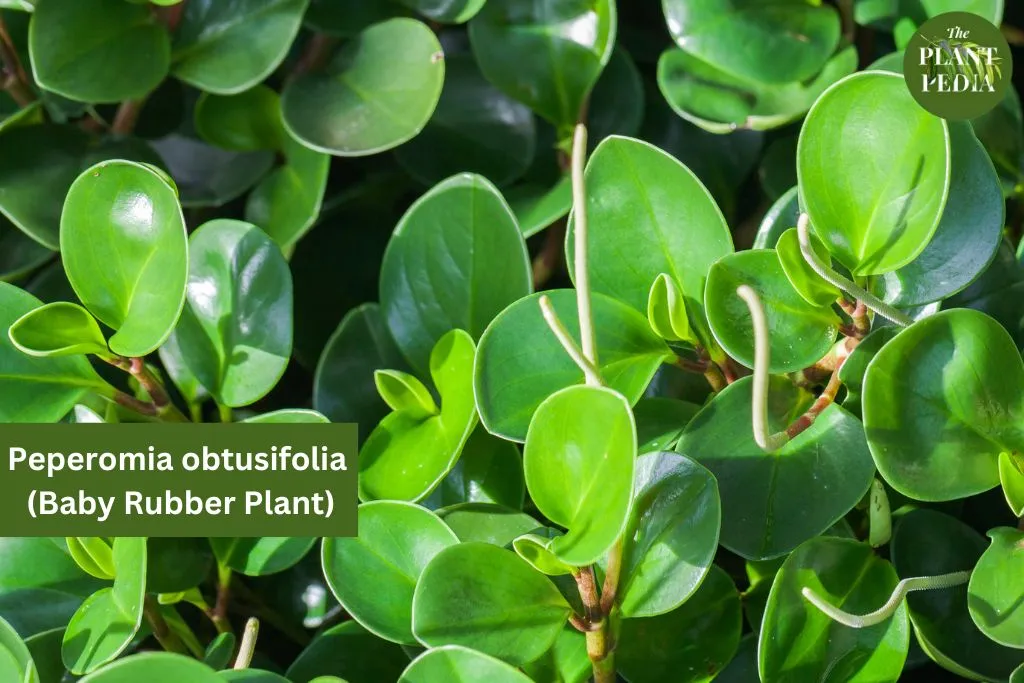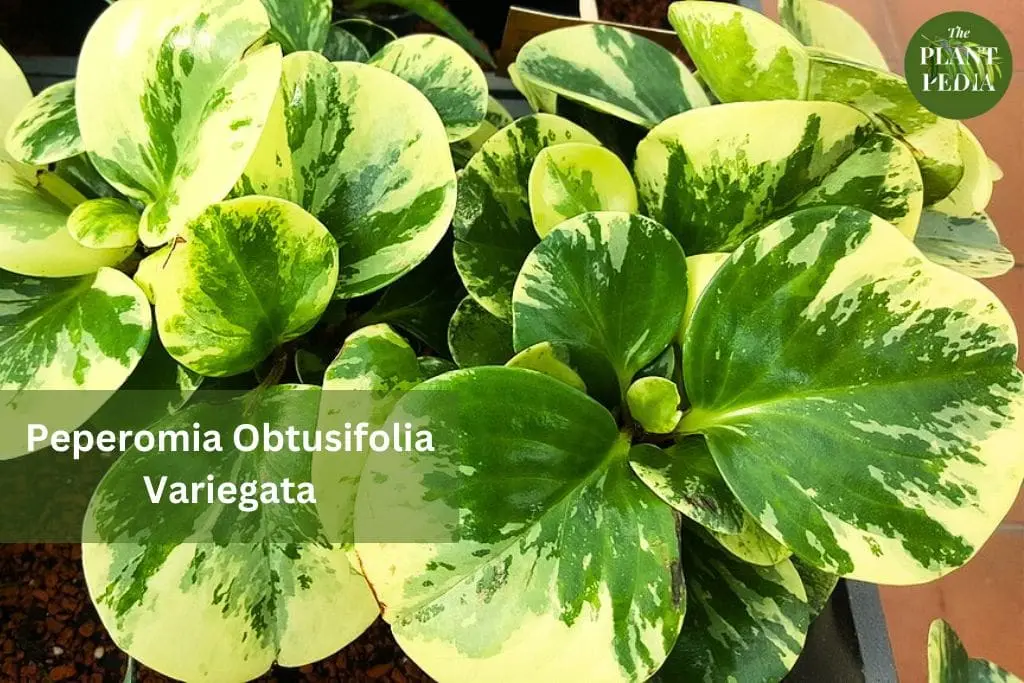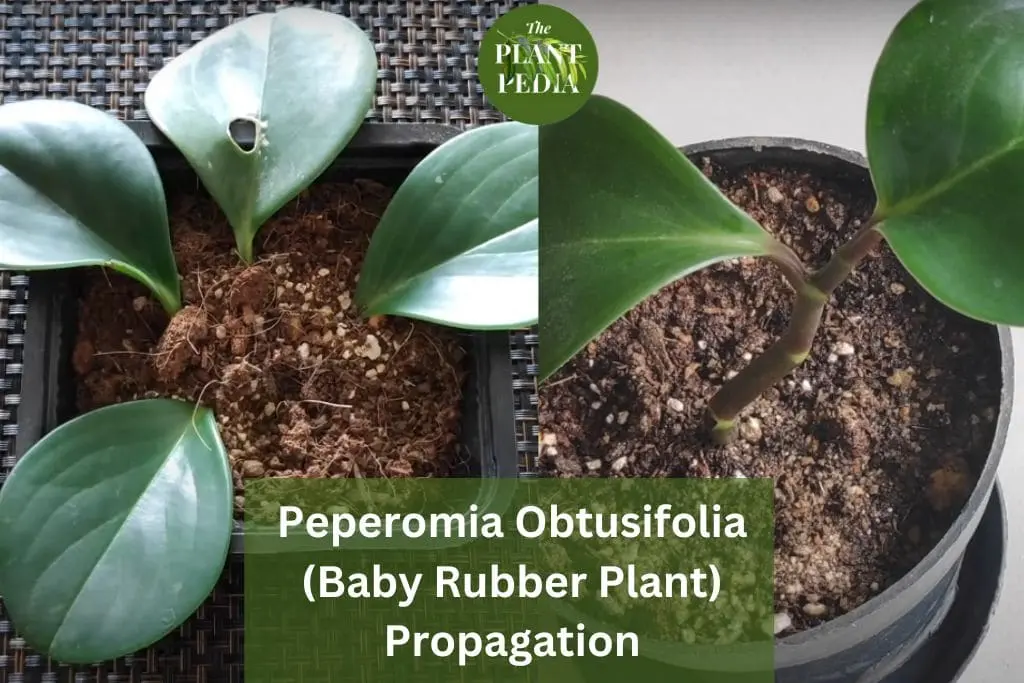Indoor gardening has gained tremendous popularity over the years, with plant enthusiasts seeking to bring nature’s beauty indoors.
One plant that has captured the hearts of many is the Peperomia obtusifolia, also known as the Baby Rubber Plant. Its attractive foliage, ease of care, and adaptability make it a favorite among both novice and experienced plant enthusiasts.
What’s even more exciting is that you can easily propagate Peperomia obtusifolia to expand your plant collection or share the joy of growing with friends and family.
In this comprehensive guide, we’ll delve into the art and science of Peperomia obtusifolia propagation, exploring various methods, tips, and tricks to ensure successful propagation.

Understanding Peperomia Obtusifolia
Before we dive into the propagation methods, let’s familiarize ourselves with the Peperomia obtusifolia plant.
Native to South America, this evergreen perennial belongs to the Piperaceae family. Its common names, “Baby Rubber Plant” or “American Rubber Plant,” stem from the similarity of its fleshy leaves to those of rubber plants (Ficus elastica).
The leaves are typically glossy, thick, and succulent, making them excellent for water retention and drought resistance.
The Peperomia obtusifolia comes in various cultivars, each with distinct leaf patterns and colors, adding to its ornamental appeal.

Read: Peperomia obtusifolia Variegata – Everything About This Beauty.
Why Propagate Peperomia Obtusifolia?
Propagating Peperomia obtusifolia, commonly known as the Baby Rubber Plant, offers a range of benefits for plant enthusiasts.
This popular houseplant has captured the hearts of many due to its charming appearance and low-maintenance nature.
Here are some reasons why propagating Peperomia obtusifolia can be a rewarding endeavor:
1. Expansion of Your Plant Collection:
Propagation allows you to grow new plants from your existing Peperomia obtusifolia. If you’re looking to expand your indoor plant collection, propagation provides a cost-effective way to do so.
You can have multiple plants in various rooms of your home or share them with friends and family, spreading the joy of gardening.
2. Rejuvenation of Older Plants:
Over time, mature Peperomia obtusifolia plants can become leggy or lose their vibrant appearance. Propagation offers a chance to rejuvenate older plants.
By propagating healthy cuttings, you can encourage new growth and create more compact, attractive specimens.
3. Learning About Plant Reproduction:
Propagation is an excellent opportunity to learn about plant biology and reproduction. It gives you a firsthand experience of how plants develop roots and grow from cuttings.
Understanding these processes can deepen your appreciation for plants and help you become a more knowledgeable gardener.
4. Sharing with Others:
If you have fellow plant enthusiasts in your circle, propagating Peperomia obtusifolia provides an opportunity to share your passion.
Gifting a propagated plant to a friend, family member, or colleague can be a thoughtful gesture that spreads the joy of gardening and adds a touch of greenery to their spaces.
5. Enhancing Indoor Greenery:
Indoor plants offer numerous benefits, such as improving air quality and enhancing the aesthetic of your home.
By propagating Peperomia obtusifolia, you can increase the number of plants in your indoor garden, creating a more lush and inviting environment.
6. Experimenting with Different Methods:
Peperomia obtusifolia can be propagated using various methods, including leaf cuttings, stem cuttings, and water propagation.
Trying out different propagation techniques can be a fun experiment and a learning opportunity to discover which method works best for you and your plants.
7. Creating Custom Arrangements:
Once you have successfully propagated Peperomia obtusifolia, you can use the new plants to create custom arrangements and displays.
Combine them with other indoor plants in decorative pots or terrariums to add visual interest and creativity to your living space.
8. Contributing to Sustainability:
Propagation can contribute to sustainability efforts by reducing the demand for commercially grown plants.
When you propagate your plants, you reduce the need to purchase new ones, which can help decrease the environmental impact associated with plant production and shipping.
Read: Can Baby Rubber Plant Grow in Water?

How to Propagate Peperomia Obtusifolia
Peperomia obtusifolia can be propagated through several methods, each with its own set of advantages and challenges.
Let’s explore some of the most popular propagation methods:
Leaf Cuttings:
Leaf cuttings are a commonly used method to propagate Peperomia obtusifolia. Follow these steps for successful leaf propagation:
- Choose a healthy leaf: Select a mature and healthy leaf from the parent plant. Make sure to choose a leaf with a visible vein, as this is where roots will develop.
- Prepare the cutting: Using a clean, sharp knife or scissors, carefully cut the leaf along with a small portion of the stem.
- Allow for callus formation: Place the cutting in a dry, shaded area for a few days to allow a callus to form at the cut end. This helps prevent rotting during propagation.
- Plant the cutting: Once calloused, plant the cutting in a well-draining soil mix. Insert the cut end about an inch into the soil and water lightly.
- Maintain humidity: To retain moisture and encourage root growth, cover the cutting with a clear plastic dome or place it in a plastic bag. Mist the cutting occasionally to maintain humidity.
- Root development: After a few weeks to a couple of months, you should start to see roots forming. Once the cutting has established a healthy root system, you can transplant it into its own pot.
Stem Cuttings:
Stem cuttings are another effective way to propagate Peperomia obtusifolia.
Here’s how to do it:
- Choose a stem: Select a healthy stem with a few leaves attached. The stem should ideally have several nodes, which are the points where leaves and roots emerge.
- Cut the stem: Using a clean cutting tool, make a clean cut just below a node. This will be the part you plant in the soil.
- Remove lower leaves: Trim the leaves near the lower end of the cutting, leaving at least one or two leaves at the top.
- Plant the cutting: Plant the trimmed end of the stem in a well-draining soil mix, burying at least one node’s length into the soil.
- Provide proper conditions: Place the cutting in a warm and humid environment. You can cover it with a plastic dome or use a propagator to maintain humidity.
- Root development: Over the next few weeks, the cutting should develop roots. Once the roots are well-established, you can transplant the new plant into its own pot.
Water Propagation:
Water propagation is a popular method for many succulent plants, including Peperomia obtusifolia.
Here’s how to do it:
- Select a healthy leaf: Choose a healthy leaf and remove it from the parent plant. Be sure to take the entire leaf, including the base.
- Place in water: Submerge the base of the leaf in a container of clean, room-temperature water. Make sure that at least a portion of the leaf is above the waterline.
- Wait for roots to develop: In a few weeks to a couple of months, you should see tiny roots emerging from the base of the leaf.
- Transfer to soil: Once the roots are a few inches long, carefully transplant the leaf into a well-draining soil mix. Plant it shallowly, with the base of the leaf just below the soil surface.
- Provide proper care: Water the newly planted leaf lightly and place it in a warm, bright location. As the plant grows, it will establish itself and develop new growth.
My Personal Tips for Successful Propagation
Regardless of the method you choose, successful propagation requires attention to detail and proper care.
Here are some tips to help you achieve the best results:
- Choose Healthy Parent Plants: Select plants that are free from pests and diseases. Healthy parent plants are more likely to produce viable cuttings or leaves for propagation.
- Use Clean Tools: Always use clean, sharp cutting tools to prevent introducing pathogens to the cuttings.
- Provide Optimal Conditions: Maintain a warm and humid environment for your cuttings. You can use humidity domes or place your cuttings in a propagator to create a suitable microclimate.
- Don’t Overwater: While it’s important to keep the soil slightly moist, overwatering can lead to rot. Ensure that your chosen soil mix is well-draining to prevent excess moisture buildup.
- Be Patient: Propagation takes time, and it’s normal for roots to take a few weeks to develop. Be patient and resist the urge to disturb the cuttings too soon.
- Monitor Light Exposure: While bright, indirect light is generally ideal, intense sunlight can scorch young plants. Gradually acclimate your cuttings to light to prevent sunburn.
Common Challenges and Solutions
Like any gardening endeavor, propagating Peperomia obtusifolia can come with its fair share of challenges.
Here are some common issues you might encounter and how to address them:
- Rotting Cuttings: If your cuttings are rotting before they develop roots, it’s likely due to excess moisture. Ensure that your soil mix is well-draining, and avoid overwatering.
- Lack of Root Growth: If you’re not seeing any root growth, ensure that your cuttings are receiving enough warmth and humidity. You can also try using a rooting hormone to encourage root development.
- Wilting or Drooping Leaves: Wilting leaves could indicate that the cutting is losing moisture too quickly. Increase humidity by covering the cutting with a clear plastic dome or misting it regularly.
- Yellowing Leaves: Yellowing leaves might be a sign of overwatering or poor drainage. Allow the soil to dry out slightly between waterings, and make sure the pot has proper drainage.
Related FAQs:
Can I propagate Peperomia obtusifolia in water?
Yes, you can propagate Peperomia obtusifolia in water. Water propagation involves placing a healthy leaf or stem cutting in a container of water and waiting for roots to develop before transplanting it into soil.
This method works well for many succulent plants, including Peperomia obtusifolia.
How long does it take for Peperomia obtusifolia cuttings to root?
The time it takes for Peperomia obtusifolia cuttings to root can vary.
Generally, it can take several weeks to a few months for roots to develop, depending on factors like temperature, humidity, and the specific propagation method you’re using. Be patient and monitor the progress regularly.
Can I propagate Peperomia obtusifolia in soil directly?
Yes, you can propagate Peperomia obtusifolia directly in soil. Stem and leaf cuttings can be planted directly into well-draining soil for root development.
Make sure to provide the right conditions, such as warmth and humidity, to encourage successful propagation.
Do I need to use rooting hormone for Peperomia obtusifolia propagation?
While using rooting hormone isn’t strictly necessary for Peperomia obtusifolia propagation, it can increase the chances of successful rooting, especially if you’re experiencing difficulties.
Rooting hormone provides a boost of hormones that promote root development, making it a helpful tool, especially for more challenging propagation scenarios.
What type of soil is best for Peperomia obtusifolia propagation?
A well-draining soil mix is crucial for Peperomia obtusifolia propagation. A mix designed for succulent or cactus plants works well, as it allows excess moisture to drain away from the roots, reducing the risk of rot.
You can also create your own mix by combining potting soil with perlite or sand to enhance drainage.
Can I propagate variegated Peperomia obtusifolia?
Yes, you can propagate variegated Peperomia obtusifolia. Keep in mind that if the variegation is caused by a mutation, not all propagated plants may retain the variegation.
Some new plants may revert to the standard green form. If variegation is a priority, consider propagating from sections of the plant that already exhibit variegation.
When is the best time to propagate Peperomia obtusifolia?
The best time to propagate Peperomia obtusifolia is during its active growth period, which is typically in the spring and summer months.
During this time, the plant is better equipped to recover from the stress of propagation and establish new roots.
Can I use leaf fragments for Peperomia obtusifolia propagation?
While using leaf fragments might work for some plants, Peperomia obtusifolia is generally propagated from whole leaves or stem cuttings that include at least one node.
Nodes are essential for root and shoot development, so it’s recommended to use intact sections of leaves or stems.
How often should I mist the cuttings during propagation?
Misting the cuttings every 2-3 days is a good starting point to maintain humidity during propagation. However, avoid over-misting, as excessive moisture can lead to fungal issues.
Pay attention to the humidity levels in your environment and adjust misting frequency accordingly.
Can I propagate Peperomia obtusifolia from seeds?
While it’s possible to propagate Peperomia obtusifolia from seeds, it’s not a common method.
Seeds can be slow to germinate, and the resulting plants may not exhibit the same characteristics as the parent plant.
Propagating from cuttings is generally more reliable for maintaining the traits of the original plant.
Conclusion
Peperomia obtusifolia propagation is an exciting and rewarding journey that allows you to create new plants and expand your indoor garden.
Whether you choose leaf cuttings, stem cuttings, or water propagation, understanding the basic principles of plant biology and providing optimal care are key to successful propagation.
As you embark on this green adventure, remember that each step—choosing the right parent plant, making clean cuts, providing the right conditions, and being patient—contributes to the overall success of your propagation efforts.
With time and dedication, you’ll witness the growth and development of new Peperomia obtusifolia plants that you can proudly share with friends and family, contributing to the ever-growing world of plant enthusiasts.
